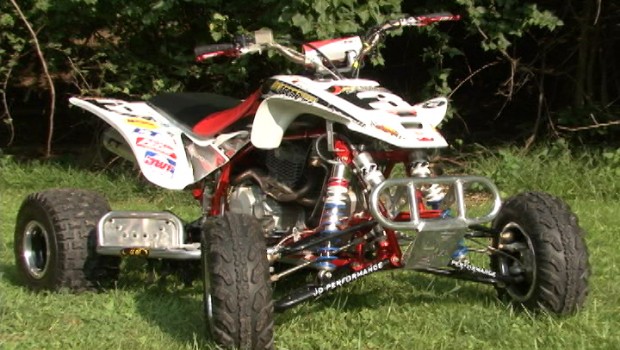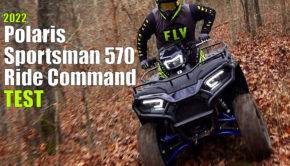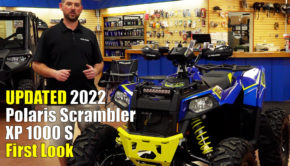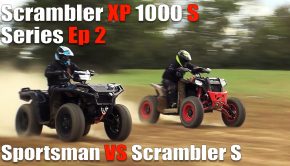JD Performance Sport ATV MX A-Arm Test–WITH VIDEO
The design, width, and stability your sport ATV needs without the commercialized price you don’t.
Today, many trail systems are cutting their ATV and UTV trails between 50 and 60-inches wide. Motocross racers, sand dune riders, and now a growing number of trail riders can benefit from the improved handling and control of riding an ATV closer to 50-inches wide, than the traditional 45 to 46-inch width. Most motocross races allow a maximum width of 50 inches, and going wider generally only has an adverse effect, causing you to lose front-end traction.
If you’re considering widening your ATV, the price can be a bit deterring. First, most of the a-arms widely recognized from big magazine ads and highly sponsored pro racers cost anywhere between $1,000 and $2,500. Spending another $1,500 on front shocks is no problem if you can afford it. However, for most racers and recreational riders, that’s simply not necessary.
The JD Performance Difference
Pricing some new a-arms and shocks for an upcoming build, we were reminded of the seemingly unobtainable pricing floating around, and of a front-end we had tried in the past with a high level of success that came at half the price of some of the front-ends we’ve seen.
Dave Herron worked for Laeger’s chassis components, building their Pro-Trax frames during the late 1980 and 90s. When the AMA instated a production frame rule for the pro class, the demand for aftermarket frames was reduced. At that time, Dave left Laeger to pursue his own company, JD Performance, where he focused on building a-arms and the other chassis components still being commonly used on production frames. JD Performance isn’t a widely known company since they keep their advertising and sponsorship overhead down in an effort to keep their retail prices low.
JD Performance builds their products in house in the USA. They offer four basic a-arm options: standard shock length, long travel shock length, and both are available in either standard or maximum ground clearance. They construct their a-arms of tig-welded 4130 chromoly, which are available in various extended lengths to suit your needs. They come complete with ball joints, tie rods, and all necessary mounting hardware including graphite-impregnated hard urethane bushings. The urethane bushings can be upgraded to needle bearings at the time of purchase for $70.
All of JD Performance’s a-arms feature their, “faster caster” caster adjustment system providing three different caster settings. You can move them back for high-speed desert, to the middle for all-around trail riding, or forward for faster turning on the motocross track. Adjusting caster takes place by moving the upper a-arm’s shims to the back, either side, or front of the arm. The “faster caster” system offers less ability to fine-tune your caster; however, it is quick and doesn’t require measuring your caster settings. It works well enough that Can-Am started using the design on its DS450 ATVs. JD’s arms also offer one of the easier camber adjustment designs.
Standard shock and standard clearance a-arms retail for a modest $495 and just $105 more if you want long travel. JD Performance covers their a-arms with a lifetime manufacturer’s warranty against defects. If you plow a tree or crash and wad one up, JD Performance will sell you a replacement single arm if needed.
The right setup for you
If you have rebuildable front shocks, you may be able to have them modified to work with long travel a-arms. Check with your favorite suspension tuner of JD Performance if you aren’t sure. If your rebuildable stock shocks can’t be extended, you will need standard shock a-arms; if you have a machine with non-rebuildable front shocks you will need to buy aftermarket shocks. Most shock builders charge the same price for standard or long travel shocks these days. With only a $105 price difference between JD Performance standard and long travel a-arms, you might as well opt for long travel a-arms and shocks. Keep In mind that long travel usually has more to do with the length of the shock than the actual wheel travel, although the quality of travel is generally better on a long travel shock.
Our setup
When we built our 400EX a few years back, many manufacturers were charging significantly different prices for standard and long-travel front ends, so we opted to go with JD Performance Standard Shock A-arms. We went +3 inch wider a-arms and switched from the stock 3+2 to 4+1 offset front wheels. This setup yields a machine that measures in four-inches wider at 49.5-inches wide, while the reduced wheel offset reduces steering effort and bump feedback felt through the steering.
Since the 400EX features disposable front shocks, we went with PEP’s Limited Mass remote reservoir-equipped shocks featuring compression adjustment for $1070. If we were doing this build today, we would stick with the limited mass shocks, but go with the long travel a-arms for virtually the same price.
If you’re happy with the performance of your rear shock and you don’t change your swingarm length, you may be able to leave the rear shock alone and save yourself some dough. Since it’s necessary to widen the front and rear of your ATV together, we swapped out the stock axle with a Tusk Racing axle from Rocky Mountain ATV for $199.95.
The Test
The JD Performance A-arms bolted up flawlessly. The arms’ welds are clean and consistent, as we would expect from a fabricator with Dave’s extensive experience. We liked the arms’ MX caster setting for tight tracks, while we sometimes switched to the middle, woods’ setting for faster, more wide open tracks.
With the JD Performance a-arms and PEP Limited Mass shocks installed, we got exactly what we were looking for out of our machine’s new front end. Cornering stability was dramatically improved. We could carry a lot more speed into, through, and out of turns. Carrying more momentum through turns let us clear some jumps that would have been nearly impossible on the less stable 45.5-inch wide stock machine. Off road or in the dunes, the extra width would be a big asset both in turns and on side hills. The improved stability also comes in handy when you land a little crossed up on jumps.
The combination of the JD Performance arms and PEP shocks yield 10.5 inches of suspension travel; all the travel you need for motocross. The PEP shocks helped keep the front end flat through corners and ate up the biggest hits we threw at them without ever bottoming hard.
Conclusion
JD Performance builds a good product at a very reasonable price. We’ve been reluctant to use many lower priced a-arms for fear of sacrificing quality construction combined with the fact that our test riders like to push the limits of man and machine.
Having inspected, installed, and tested JD Performance arms, we wouldn’t hesitate to use or recommend them.
Manufacturer: JD Performance
Product: Standard Shock +3 A-arms
Price: $499
JD Performance Sport ATV MX A-Arm Test
Summary: JD Performance builds a good product at a very reasonable price. We’ve been reluctant to use many lower priced a-arms for fear of sacrificing quality construction combined with the fact that our test riders like to push the limits of man and machine. Having inspected, installed, and tested JD Performance arms, we wouldn’t hesitate to use or recommend them.










